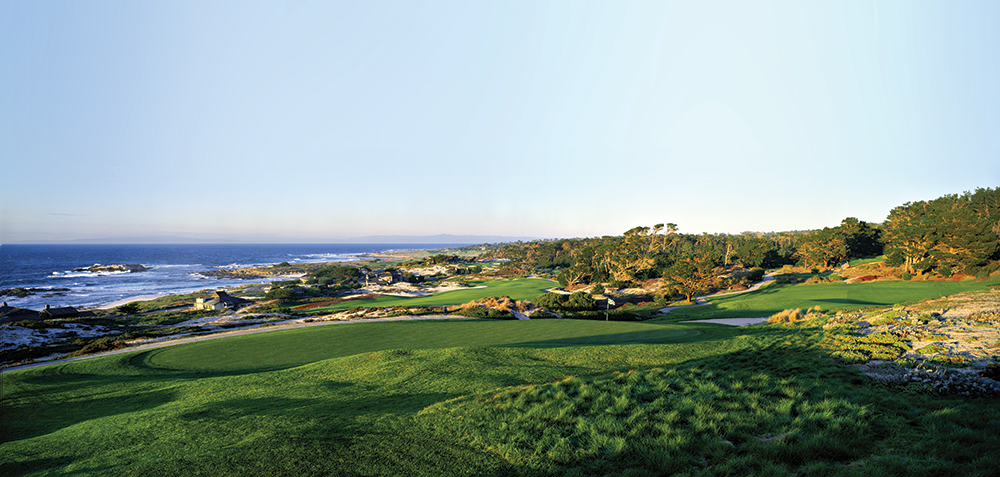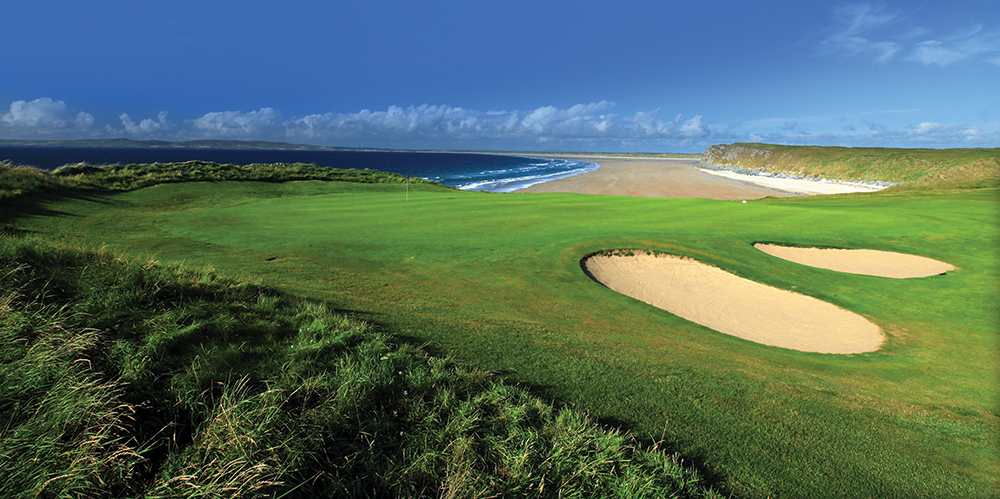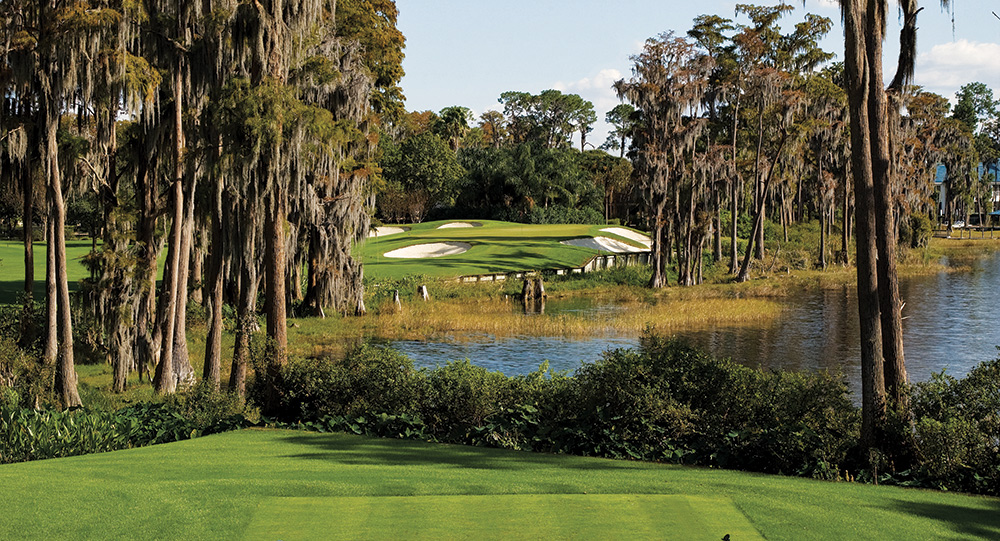
The first hole on a golf course is generally used as a way of getting players up and running, often lulling them into a false sense of security. The second hole, however, is rarely as nice—deliberately so. This is where players start earning their corn as they come down to earth with a bump. In our latest numbers game, we have put together an 18-hole layout from some of the world’s beastliest and most iconic No.2s.
Chambers Bay Golf Course, Tacoma, WA
Par-4, 421 yards
It was impossible to resist the temptation to tee off our latest 18-hole collection with a really picturesque No.2. Chambers Bay on the Washington coast is certain to enchant players and fans when the U.S. Open comes calling in 2015—and this hole looks destined to stick in the memory. Named Foxy after the 14th at Royal Dornoch in northeast Scotland, this gem, heading due north and doglegging slightly from right to left, starts in the dunes and opens toward Puget Sound at the landing area. A small hummock bisecting the fairway directs balls right or left. The approach from the right is open and favors a running draw while from the left an aerial approach over a greenside sandy area is required. The green slopes gently from right to left and features an especially dramatic back-left hole location.
chambersbaygolf.com
Bay Hill Club & Lodge, Orlando, FL
Par-3, 231 yards
Confronting competitors immediately after Bay Hill’s awkward, right-to-left dogleg 1st, this long, elusive par-3 forms an integral part of perhaps the trickiest opening stretch at any regular tournament destination. In its own right, this is traditionally one of the most difficult par-3s to be found on the PGA Tour. A mid-to-long-iron is required to reach this hole where the green slopes severely from right to left. Par here is a great score, but anyone attempting to play this hole properly should avoid even the center of the green, let alone the left side, no matter where the pin is placed. Shots hit seemingly too far right actually have an excellent chance of feeding back on to the green, while anything remotely left of center is guaranteed to be short-sided to leave a tough up-and-down.
bayhill.com
TPC Boston, Norton, MA
Par-5, 554 yards
TPC Boston, one of New England’s outstanding courses, opened in 2002 to an Arnold Palmer design and hosts the Deutsche Bank Championship during the FedExCup playoffs. The 2nd is a high-quality, left-to-right dogleg where par is a more than acceptable score, even for most professionals. The tee shot, framed by the tree line on both sides of the fairway, is over a small stream and should be aimed left of the bunkers guarding the landing area to the right. The second shot for most players is a lay-up short of the lake that eats dramatically into the fairway from the right. A three-tier green awaits the approach, so attention needs to be paid to the pin placement. As the club website cheerfully observes: “Hit your mark and you’re home free. Miss and you’re looking at a double-bogey on the rocks.”
tpc.com/boston
Highlands Links Golf Club, Nova Scotia, Canada
Par-4, 447 yards
Part of the spectacular Cape Breton Highlands National Park, this Stanley Thompson layout dates back to 1941 and is regarded as one of Canada’s finest public courses. Thompson, the godfather of Canadian golf-course design with more than 140 courses to his name, excelled himself when it came to the layout of Highlands Links, which is wedged between the Atlantic Ocean and the Gulf of St. Lawrence, and is flanked by a stunningly beautiful patchwork of beaches, mountains, rivers and valleys. This downhill hole has approximately 110ft of elevation change from tee to green. From the tee box, with a magnificent view of the shoreline, golfers play to a narrow fairway dotted with links-like mounds and contours. From there, the bunkerless green presents an ‘open house’ to balls landing short and running on.
highlandslinksgolf.com

Spyglass Hill Golf Course, Monterey Peninsula, CA
Par-4, 349 yards
After slogging along the 600-yard opening hole at Spyglass Hill, players could be forgiven for feeling in need of some light relief. Alas, contrary to appearances, they won’t get it at this deceptively short, uphill par-4, which is exposed without mercy to the vagaries of the swirling winds that invariably whistle through the Monterey Peninsula from off the Pacific Ocean. The fairway is abutted by ice plants and the approach to the green by vast, sandy waste areas. Meanwhile, a deep bunker in front of the putting surface puts an even greater premium on the need for accuracy and precision with the approach. Laid out in 1966 by Robert Trent Jones Sr. in the gap on the Del Monte shoreline between the links of Cypress Point and Pebble Beach, Spyglass Hill was always intended to be a tough test of golf.
pebblebeach.com/golf/spyglass-hill-golf-course
Augusta National Golf Club, Augusta, GA
Par-5, 575 yards
Pink Dogwood—all holes at Augusta National are named after an exotic flower or shrub—is one of the hardy perennials of the Masters Tournament. A slight draw off the tee away from the right-hand fairway bunker at this downhill, right-to-left par-5, the longest hole on the course, sets up the chance to reach the green in two. Large, deep bunkers on both sides of the front of the green often come into play, so precision is required with the approach, usually played off a downslope. The fairway runs downhill and curls to the left as it nears the green. This is where Masters competitors seek some early momentum, and many will feel they have missed an opportunity if they don’t walk away with a birdie. The lay-up is often favored regardless of the pin position.
Garden City Golf Club, NY
Par-3, 137 yards
Built by Devereux Emmet in 1901 on Long Island, less than 20 miles east of downtown Manhattan, the golf course at Garden City is invariably praised for a rustic simplicity that confounds its metropolitan setting. This is classically borne out by the short 2nd which has a long green angling from front right to back left where it is framed by an old sand quarry. In an attempt to avoid the quarry, many players bail out long and right only to end up in one of the gaping bunkers that lurk behind the putting surface. For Emmet, this would have been the easiest hole on the course to identify when he was drawing up his designs, especially as the wind that blows in off nearby Hempstead Plain can exert a considerable influence over club selection from the tee.
gardencitycountryclub.org
St. Andrews (Old Course), Fife, Scotland
Par-4, 453 yards
Four bunkers and heavy rough straddling both sides of a narrow fairway lie in wait for skewed tee shots. The Dyke this hole is named after is the old wall that forms the boundary between the Old Course Hotel and the 17th fairway. The tee has recently been moved 40 yards right on to the edge of the Himalayas putting green to bring Cheape’s bunker on the left of the fairway back into play. Second shots are often played right of the hole to avoid a fearsome pot bunker next to the green. Hazards in front of the green encourage an aerial pitch as the undulating putting surface is unpredictable for a run-up shot. During The Open, the pin is usually in the left-hand corner of the green, leaving even an accurate shot deviating left to right if it falls short in the wind.
standrews.com
Medinah Country Club (No.3), Chicago, IL
Par-3, 192 yards
The No.3 course is known for its prodigious length and narrow, tree-lined fairways, but the challenge on this 2nd hole is water. This is the only one of Medinah’s four par-3s to measure less than 200 yards, although most players would express surprise after taking a glance at Lake Kadijah from the tee. The wind plays a big role in club selection with a large bunker front right swallowing any tee shots that might have been mishit or are fading away from the target. A pot bunker will inflict similar punishment on players who miss long, but for those lucky (or skillful) enough to reach the green in regulation another challenge awaits—the green has two tiers. So, more than most holes, pin placement determines where you want to land your ball in order to two-putt.
medinahcc.org/Club/Scripts/Home/home.asp

Kiawah Island Golf Resort (Ocean), SC
Par-5, 528 yards
The 2nd hole on the Ocean Course at Kiawah Island is as challenging as it is beautiful—and there are few more scenic holes on the western Atlantic coastline. The first hurdle is to drive further than 175 yards in order to clear the marsh in front of the tee and reach the fairway. Always an immaculate carpet of impeccably groomed grass, the fairway will yield a second shot to the green from time to time, though the smart play is perhaps to lay up short of the next belt of marsh that juts across the fairway around 100 yards short of the target. In 2002, course designer Pete Dye made a few adjustments to seven of the holes and on the 2nd he bulk-headed the second marsh crossing to make the green, 110 yards away, more visible. Today, this change makes shots less likely to trickle off the green.
kiawahresort.com
Pinehurst Resort (No.2), NC
Par-4, 449 yards
Designed in 1907 by Donald Ross, Pinehurst No.2 will host the U.S. Open in 2014. Recently, it underwent a facelift from Ben Crenshaw and Bill Coore, and no finer tribute can be paid to their efforts than the words of USGA executive director Mike Davis, who said: “My mouth literally falls open when I see the incredible work they’ve done. I’ve got to say, I’m so excited about 2014 because it’s going to be a unique U.S. Open.” Tom Watson rated this one of the best second holes in the world. It’s a slight dogleg to the right, so, despite the presence of four bunkers around driving distance and out-of-bounds just beyond, the target for the tee shot is left center of the fairway. The turtle-shell green lends itself to several testing hole locations, but if the approach is shy, the ball will roll back off the green.
pinehurst.com
Southern Hills Country Club, Tulsa, OK
Par-4, 488 yards
On a course that’s famed for the difficulty of its long par-4s, this is a real gem—and proof positive that not all the great holes have to be sharp doglegs. Even though the 12th is a truly spectacular golfing experience and the 18th is one of the hardest finishing holes in the game, the 2nd at Southern Hills presents perhaps the most demanding tee shot on the golf course. The initial obstacle facing the golfer is a 240-yard carry over a pair of bunkers and a creek that winds diagonally from right to left before turning away to run parallel to the fairway down the left side. Hitting the fairway here is absolutely essential. Thereafter, a gently drawn mid-to-long-iron second shot is generally required to reach a slightly elevated green that is guarded on all four corners by bunkers.
southernhillscc.com
Congressional Country Club (Blue), Bethesda, MD
Par-3, 233 yards
How quickly the Blue Course changes its face! After a relatively gentle start, players are soon confronted by a long and extremely demanding par-3 that turned out to be almost the toughest hole in both the 1997 and 2011 U.S. Opens. Six bunkers (four right, two left) surround a relatively small green (for the length of the hole) that can be attacked with anything from a 5-iron to a hybrid or 5-wood depending on wind direction and hole location. The putting surface is divided by a ridge that runs diagonally through the middle from front left to back right. This means anything short will roll back to the front of the green while anything long and drawing will probably disappear over the back left corner. The tee shot has to be shaped correctly (as straight as possible) otherwise the ball won’t hold the green.
ccclub.org
Royal St. George’s Golf Club, Kent, England
Par-4, 417 Yards
The tee shot on the 2nd hole of the host course for this year’s [British] Open can be played either with a safe long-iron to the right side of the fairway, avoiding the two bunkers on the corner of the right-to-left dogleg though leaving at least a mid-iron approach, or with a driver over the top of the bunkers to take the angle out of the hole and reduce the second shot to a short pitch. Whichever, it will be imperative to hit the fairway as the rough is often knee-high for anything off line, especially down the left side of this hole. The approach shot—to an undulating green that tilts from back to front, and slightly from left to right, not to mention the protection provided at the front by hollows on both sides—is best played from the flatter ground on the right side of the fairway.
royalstgeorges.com

Tralee Golf Club, Co. Kerry, Ireland
Par-5, 596 yards
Pounded for centuries by the ocean off the coast of southwest Ireland, the opening holes of Tralee constitute a man-sized challenge for any golfer. The 2nd is a case in point. Players must navigate a narrow passage off the tee along the cliff edge with the sea constantly to the right before heading for the sheltered green in the “little corner” on the cliff top. Scan the view from the back tee—it’s spectacular. Next stop, America! This par-5, nicknamed the ‘Cuilin’ after a curl on the back of the head, is in essence a dogleg left to right played adjacent to the beach. The corner can’t be cut so it’s a classic three-shot hole—where each shot needs to be more exact than the last. “I’ve never come across a piece of land so ideally suited for the building of a golf course,” Arnold Palmer, the designer, said of Tralee.
Atlanta Athletic Club (Highlands), Johns Creek, GA
Par-4, 512 yards
A par-5 for the members, the 2nd on the Highlands Course at Atlanta Athletic Club has always been converted to a par-4 for major championships, and it will happen again in August for the 93rd PGA Championship. As is typical of the longer shots on this course, the ideal shape off the tee is a soft draw, curving left off the bunkers on the right from 255-345 yards out. Trees and heavy rough protect the left side of the fairway. Ideally, players will want to hit a lofted approach into this shallow, well-bunkered green as they will have a hard time stopping a long-iron on the putting surface. This green was reconfigured in 2006 when a new back-right hole location was added. The toughest pin position, though, is front right which is guarded by a deep and imposing bunker.
atlantaathleticclub.org

Isleworth Golf & Country Club, Orlando, FL
Par-3, 176 yards
Designed by near-neighbor Arnold Palmer in 1986 and tweaked by Steve Smyers just shy of two decades later, this Orlando course is one of the most exclusive in the world. The gated community of Isleworth is home to Tiger Woods and many other celebrities, not just from the PGA Tour but throughout the world of sport and entertainment. This hole, known as Cypress Chute, asks a highly pertinent question very early in the round by requiring an accurate and well-struck tee shot into a deep, narrow green, although we have decided to place it further back in our challenge. Judicious club selection is essential and for most mortals it could range from a driver to a pitching wedge. As the green has numerous subtle slopes, seemingly in every direction, no two-putt is guaranteed.
isleworth.com
Pebble Beach Golf Links, Monterey Peninsula, CA
Par-5, 511 yards
Converted into a brutal par-4 for last year’s U.S. Open, this hole was designed in 1919 to be played as a par-5. It has been played as such by the members ever since, so we’ve decided to restore it to that status, not least so it can serve as a closing ‘risk and reward’ enticement where players can choose to attempt to make amends for earlier indiscretions or flirt with a total collapse into a morass of their own creation. The tee shot is straightforward in that the first objective is to avoid the bunkers on the right side of the fairway. Anything left in the rough means playing short of the large ditch about 100 yards from the green. The putting surface is extremely narrow with menacing bunkers running along both sides. However, those in the know believe the bunker on the right is on the whole less forgiving.
pebblebeach.com
Follow Us On


| Cookie | Duration | Description |
|---|---|---|
| cookielawinfo-checkbox-analytics | 11 months | This cookie is set by GDPR Cookie Consent plugin. The cookie is used to store the user consent for the cookies in the category "Analytics". |
| cookielawinfo-checkbox-functional | 11 months | The cookie is set by GDPR cookie consent to record the user consent for the cookies in the category "Functional". |
| cookielawinfo-checkbox-necessary | 11 months | This cookie is set by GDPR Cookie Consent plugin. The cookies is used to store the user consent for the cookies in the category "Necessary". |
| cookielawinfo-checkbox-others | 11 months | This cookie is set by GDPR Cookie Consent plugin. The cookie is used to store the user consent for the cookies in the category "Other. |
| cookielawinfo-checkbox-performance | 11 months | This cookie is set by GDPR Cookie Consent plugin. The cookie is used to store the user consent for the cookies in the category "Performance". |
| viewed_cookie_policy | 11 months | The cookie is set by the GDPR Cookie Consent plugin and is used to store whether or not user has consented to the use of cookies. It does not store any personal data. |